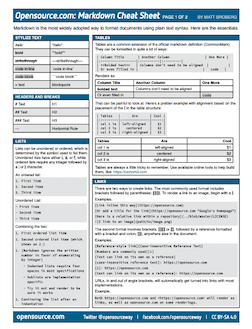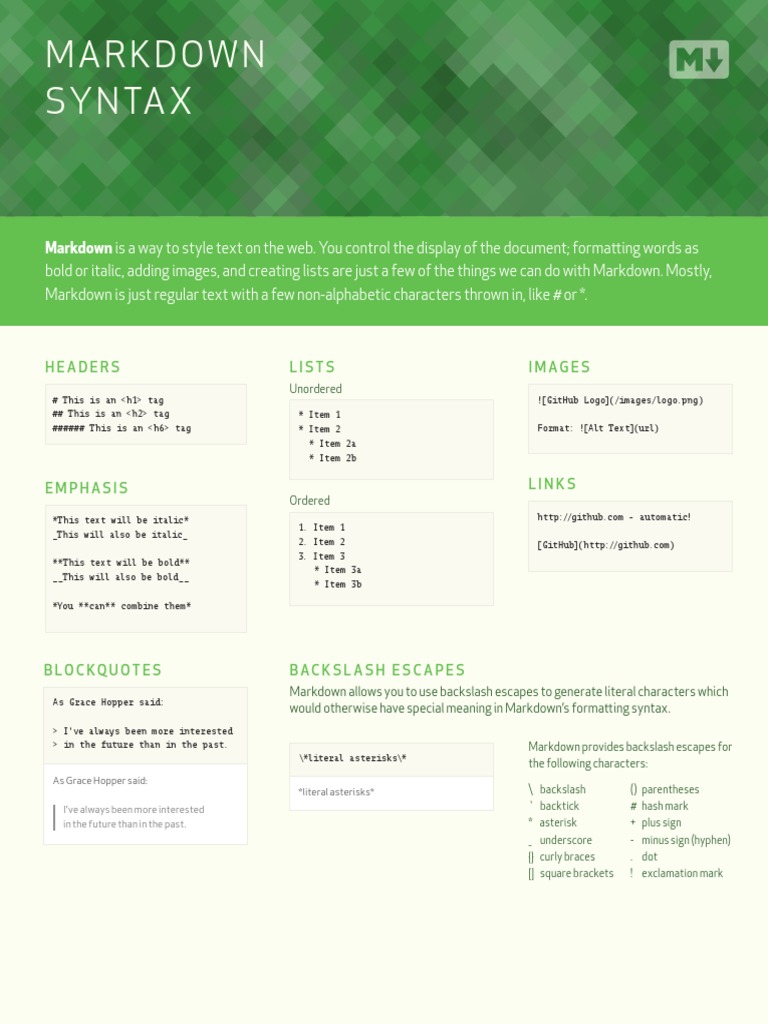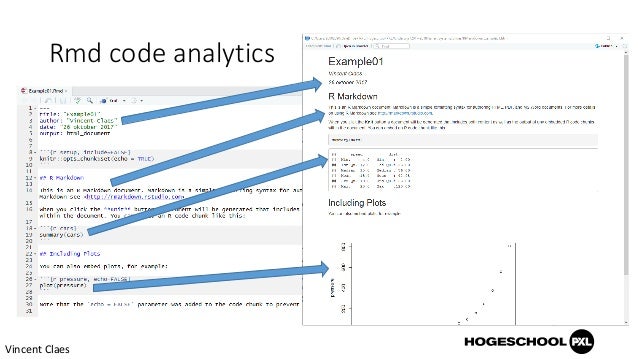Conclusion Even though markdown is a small and deliberately simple specification, it can be a little confusing to get started with. The best way to learn is to use a cheat sheet and write your Markdown document. You can update your README.md on GitHub, and you can get a lot of support from your editors’ built-in functions. As a side note, GitHub also supports emojis which you can add. Photo by Christopher Gower on Unsplash. W hat is Markdown? Markdown is a way of writing rich-text (formatted text) content using plain text formatting syntax. From this post, you’ll learn all the Markdown’s major commands that will help you create an awesome GitHub README.
A quick reference to Markdown.

Github Markdown Cheat Sheet Color
Created on: 2018-07-19
Tag: cheat_sheet
There are many styles support in Markdown. So of them are as follows:
Italics
To make a phrase italic in Markdown, we can surround words which may span multiple words with an underscore '_' or '*' without quotes. For example:
Both gives the following output:
Writing in Markdown is not that hard! Chicago nxs set is done!games123 nr2003 designs.
Bold
To make phrases bold in Markdown, we can surround words which may span multiple words with two asterisks '__' or '**' without quotes. For example:
Both gives the following output:
Writing in Markdown is not that hard!
Strikethrough
To strikethrough a phrases in Markdown, we can surround words which may span multiple words with two asterisks '~~' without quotes. For example:
Gives the following output:
Headers
To make headers in Markdown, we preface the phrase with a hash mark '#' without quotes. There are six types of headers, in decreasing sizes. We need to place the same number of hash marks as the size of the header we want:
Gives the following output:
Header two
Header three

Header four
Header five
Header six
Alternatively, for Header one and Header two, an underline-ish style can be used:
Giving the same output of Header one and Header two:
Links
There are two different link types in Markdown:
Inline
Reference
Inline
To create an inline link, we need to wrap the link text in brackets '[ ]' without quote, and then we wrap the link in parenthesis '( )' For example:
Gives the following output:
Above is the simplest way of Markdown inline link. Here are some more examples:
Reference
To create a reference link we wrap both the link text and the reference text in brackets '[ ]' without quote and at the bottom we write the reference by wrapping the reference text in '[]' followed by a ':' both without quote and then we put the actual URL. For example: Physics ch.11static electricitymr.s learning website.
Gives us the following output:
Here's a link to something else.
Above is the simplest way of Markdown reference link. Here are some more examples:
Images
If we know how to create links in Markdown, we can create images, too. The syntax is nearly the same.
To create an inline image link to https://octodex.github.com/images/bannekat.png, with an alt text that says, Benjamin Bannekat, we would write this in Markdown:
Giving us the following output:
This is called the inline style of image linking. Here are a few alternative ways to do it:
They both give us the following output:
We can also link an image with reference linking same as the Reference type of Links with the only difference where we need to put '!' without quote to the reference text. For example:
Gives us the following output:
The first father
The second first father
We can also do it like this:
Giving us the following output:
Blockquotes
If we need to call special attention to a quote from another source, or design a pull quote for a magazine article, then Markdown's blockquote syntax will be useful.
To create a block quote, all we have to do is preface a line with the 'greater than' caret '>' without quote. For example:

Gives us the following output:
I read this interesting quote the other day:
'Her eyes had called him and his soul had leaped at the call. To live, to err, to fall, to triumph, to recreate life out of life!'
We can also place a caret character on each line of the quote. This is particularly useful if your quote spans multiple paragraphs. For example:
Gives us the following output:
His words seemed to have struck some deep chord in his own nature. Had he spokenof himself, of himself as he was or wished to be? Stephen watched his face for somemoments in silence. A cold sadness was there. He had spoken of himself, of his ownloneliness which he feared.
- Of whom are you speaking? Stephen asked at length.
Cranly did not answer.
Lists
There are two types of lists in the known universe: unordered and ordered. That's a fancy way of saying that there are lists with bullet points, and lists with numbers.
Unordered
To create an unordered list, we'll want to preface each item in the list with an asterisk '*' or '-' or '+' without quote, one item par line. For example, a grocery list in Markdown might look like this:
Giving the output:
Milk
Eggs
Salmon
Butter
Occasionally, you might find the need to make a list with more depth, or, to nest one list within another. For example:
Gives us the following output:
Tintin
A reporter
Has poofy orange hair
Friends with the world's most awesome dog
Haddock
A sea captain
Has a fantastic beard
Loves whiskey
Possibly also scotch? Zeus stormzeus.
Ordered
An ordered list is prefaced with numbers, instead of asterisks. Take a look at this recipe:
Crack three eggs over a bowl
Pour a gallon of milk into the bowl
Rub the salmon vigorously with butter
Drop the salmon into the egg-milk bowl
To write that in Markdown, you'd do this:
We can also make unordered list under ordered list and vice-versa.
Paragraphs
Markdown has several ways of formatting paragraphs. If we forcefully insert a new line for each line, we would end up having a paragraph for each line. For example:

Would result in:
Do I contradict myself?
Very well then I contradict myself,
(I am large, I contain multitudes.)
This is called a hard break; where we can have soft break but giving two space ' ' without quote at the end of each line. For example:
Which will be rendered as
Do I contradict myself?
Very well then I contradict myself,
(I am large, I contain multitudes.)
Without the line break or two spaces, Markdown will consider all three line as one.:
Giving:

Do I contradict myself?Very well then I contradict myself,(I am large, I contain multitudes.)
Note
markdown-here Markdown Cheatsheet: Code and Syntax Highlighting, Tables, Inline HTML, Horizontal Rule, Line Breaks, YouTube Videos
Many website supports markdown or somewhat modified versions of markdown. I am listing a few bellow.
It would seem as of Sept 11, 2019; Markdown is not supported in Facebook Post but it supports in Facebook Messenger. Messenger markdown support:
Bold with *text*
Italics with _text_
Strikethrough with ~text~
Monospace with `text`
Codeblock with:
LaTeX typesetting with (text)
source: https://www.facebook.com/help/147348452522644
Workplace
Github Flavored Markdown Cheat Sheet
Workplace by Facebook (sort of Facebook for organization) supports Markdown on both Messenger and Post.
Bold with **text**
Italics with *text*
List with - item
Link with [title](https://facebook.com)
Numbered list with 1. first item
Quote with > quote
H1 with # Heading
H2 with ## Heading
Inline code with code
Github Flavored Markdown Cheat Sheet
source: https://www.facebook.com/help/work/541260132750354
